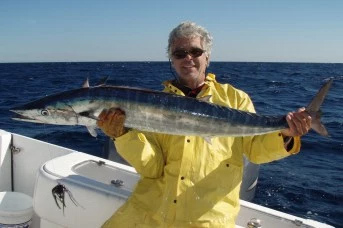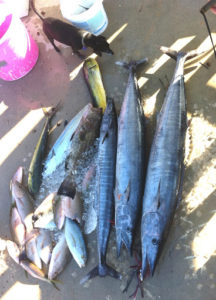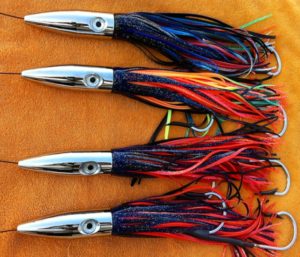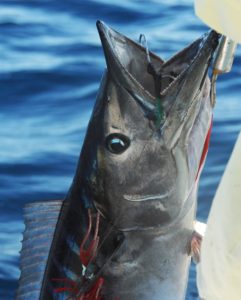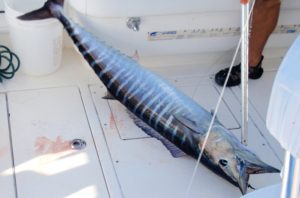Having a home on the water in the Florida Keys for the last fifteen years has had a lot of advantages and I feel truly blessed. One of the many benefits has been the friends I’ve made in my neighborhood. A close one lives at the end of my canal on the open bay. His name is Roger, but I call him Ahab because although he’s a great guy, he can be pretty ornery and we like to give each other a hard time. He calls me Parker. (Long story) In the mid-nineties he purchased a second home in Tavernier. It was the same time that we bought our house, just across the canal from him. Over the years, I would see him cleaning countless trophy fish, after days of fishing in his 31 foot Contender. I was especially envious when I would see him with monster wahoo, my favorite of all offshore species to catch.
One day, he and I got to talking across the canal. It didn’t take long for us to become good friends and fishing buddies. The better I got to know and more I fished with him, the more I realized how absolutely astounding his fishing knowledge was. To say that he has it down to a science would be an understatement. He knows which weather would be best for each specific kind of fishing, which currents are more advantageous, what water clarity and temperature is preferred, the right wind speed and direction, what fronts are good, ideal air temperature, season and moon phases. Heck, I wouldn’t be surprised to hear that he could tell you the fishes’ zodiac signs.
Through his decades of hardcore fishing, he has become an especially proficient wahoo fisherman. While I had caught plenty of them as a by-product of bait fishing on the reef or trolling for mahi mahi, he targets them by high-speed trolling offshore. When one early-spring day he invited me to high-speed troll for wahoo, he didn’t have to ask twice. His friend Hernan and I met him on his dock at 6:30 in the morning and we loaded the boat. I hoisted the two wahoo rods on board and stowed them in the long, mid-ship hatches. Wahoo rods are heavy-duty and bent about a third of the way down. They have thick, reinforced, aluminum butts with notches on the bottom to keep them straight in the rod holder. They are bent towards the rear of the boat because they are used the pull a lot of weight at high speeds. A conventional rod would not be able to take the strain and would either wear out or snap when the fish hit the lure. In the fishing world, they are referred to as bent-butt rods. Attached to them are large Penn International conventional reels with 120lb test braided line.
As we wound our way through Tavernier Creek, I could sense my excitement about wahoo fishing with a pro. We were hoping for good high-speed trolling conditions. They consist of a calm sea, a strong current and good, clean, blue water. When we cleared the ocean-side channel, we veered right and headed south towards Islamorada. When we hit the drop-off from double to triple digits in depth, we were happy to see that the seas were calm and the current was flowing. We continued on a southeasterly direction until we found a current rip in about 350 feet of water. We noticed to our satisfaction that the water was bright blue and crystal clear. Hernan manned the wheel and maintained a steady pace of nine miles per hour while Roger and I donned gloves. We each retrieved a bent-butt combo and set them in opposing rod holders on either side of the boat.
We attached safety harnesses from each reel to nearby cleats. Those are used in the event that the strike is so violent that it rips the rod out of the holder. That way we’d be spared having to watch as $1,200 worth of gear skipped across the surface of the water, being dragged away from us at a high rate of speed. At the end of the braided line is a 250# swivel. To that, we attached 24 and 36 ounce cigar weights respectively. To them, we clipped thirty feet of 250# mono-filament shock leader. Finally, we attached heavy, bullet-shaped, stainless-steel tipped, skirted lures with steel cable and double hooks. While Hernan drove straight ahead at nine miles per hour, Roger let out his line to a count of thirty and I let mine out to a count of fifty. When that was done, Roger took the helm and bumped our speed up to fifteen miles per hour.
Roger steered the boat and followed the rip from 350 to 450 feet and back then back to 350, slowly weaving so that the lures had a chance to work outside of the boat’s wake. After a while, I found myself mesmerized from watching the frothing white wake as in cut through the flat-calm, azure water. The spell was broken suddenly by the “krrraaaaaaaaaaaakkkkkkkkk” sound of the port-side Penn International’s drag screaming out at ear-splitting decibels. The line ripped off the spool at an alarming rate as we continued at 15 miles per hour and the fish shot out at speeds of up to 50 miles per hour. The line pulled non-stop and the “krrrraaaaaaaaaakkkkkkkkkkk” of the drag on the reel filled our ears, as I regarded Roger. He was as cool as a cucumber as he manned the helm, seemingly oblivious to the mayhem that was happening in the port-side stern of the boat.
“Aren’t you gonna slow down?” I bellowed over the racket. He responded, “Wahoo travel in packs. I want to see if we can pick up another one.” The words weren’t even out of his mouth when, “krrrraaaaaaaaaaaaakkkkkkkkkkkkk” the reel at my hip starting began ripping out line at blinding speed and deafening sound. After about sixty seconds, with a twinkle in his eye, Roger said, “Now I’ll start to slow down Parker.” He eased the throttle back till we were going about 7 miles per hour. He turned towards me and the stern of the boat and said, “Your instinct is to slow down when you get a fish on. It costs people a lot of fish. When you have that much line out, a quick deceleration will cause a big bow in the line. A lot of times, the hooks will just fall out when you do that. When you do finally slow down, never take it out of gear. You always want to keep that pressure on. Plus, it helps you control the fish. It’s especially helpful when you have two fish on like we do.” By now, Hernan had manned the portside bent-butt and without taking it out of the rod holder, he began winding furiously. I took that as my cue and stepped up to big reel and got on it.
After just a few winds, the fish took off and the line began peeling off. As soon as it stopped, I started cranking. On and on it went, wind, lose line, wind, and lose line, for what seemed like a long time. I glanced over at Hernan and he seemed to be in the same situation as me. All the while, Ahab heckled us over our shoulders, telling us how badly the fish were kicking our butts and how pathetic we were.”Do you girls need and hand or can you handle it? Bring them to the boat already!” and so on. After what seemed like an eternity, I heard Roger say, “I see color on yours Parker. It’s a nice fish!” He grabbed a gaff and stepped back towards my rod. “Reel the weight up to the tip.” he said. He grabbed the shock leader as he stepped up to the transom. With the gaff in hand, he slowly brought the leader in until the fish was in sight.
It was beautiful! Its stripes were lit up and bright and gleaming in the morning sun. It looked enormous in the water underneath us as Roger eased it closer to the surface and the gleaming tip of the gaff. With a strong, upwards motion, he struck the fish in its thick underside as he simultaneously let go of the leader and grabbed the gaff with both hands. When he had a good grip on it, he stepped back and heaved the wahoo into the boat. I let out a hoot as he dropped the glorious specimen onto the floor of the boat. I was awestruck by the beauty of the colors, size and obvious power of this beautiful fish. “It’ll go about forty pounds” Roger said casually, as her turned his attention to the other fish. “I still can’t see color on that fish Flaco! (Hernan’s nickname) What the matter, you didn’t eat your spinach today or what?”
After a while longer, we began to see Hernan’s fish flashing and circling under the boat. I grabbed the leader and began winding it up hand over hand. Roger got into position and struck perfectly with the gaff. The two of us grabbed it and hoisted the fish over the side of the boat. “Wow!” I exclaimed. “That one will go about fifty pounds.” Roger said. We stepped gingerly as the behemoth fish flapped around the floor of the boat, careful not to get in the way of its razor-sharp teeth. I high-fived Hernan while we gave Ahab some grief about his poor gaffing skills (though they were perfect). We took some photos and then buried the wahoo in the ice box. “That’s great sushi!” Hernan said. “The best there is!” I agreed.
Roger said, “Well guys, we’ve got ninety pounds of wahoo in the boat. What do you say we switch it up and go look for some mutton snapper?” With that, we stowed the lures, weights and shock cords, untied and put away the bent-butts, turned to the northwest and hit the throttle. I was stoked. I had fished with and learned from a true expert. He gave me hands-on training on how to catch one of the most amazing and awe-inspiring game fish in the ocean. Wahoo!!!

